Nebulae, the interstellar clouds composed of dust, hydrogen, helium, and other ionized gases, play a fundamental role in our understanding of the universe. These celestial entities provide key insights into the processes governing the birth, life, and eventual demise of stars. For both the amateur astronomer and the academic researcher, a clear comprehension of the different types of nebulae and their observable characteristics is essential.
In this article:
There are four main types of nebulae in the universe. Emission nebulae are bright, glowing clouds of gas that shine with their own light. Often filled with ionized hydrogen, they radiate a characteristic pinkish-red hue when peered at through telescopes. This vibrant glow stems from high-energy photons from neighboring stars exciting the gas particles within the nebula. The Orion Nebula stands out as a shining example of an emission nebula. It’s among the brightest nebulae and can even be spotted with the naked eye under clear, dark skies, just below the prominent stars that make up Orion’s belt.
Reflection nebulae, in contrast, don’t produce their own light. Instead, they earn their luminescence by reflecting the light of nearby stars. They frequently exhibit a blue tint, owing to the scattering of blue light more than other colors, a mechanism paralleling the blueness of our daytime sky. The Witch Head Nebula, situated in the Eridanus constellation, mirrors this phenomenon beautifully, gleaming with a bluish sheen as it reflects light from the adjacent star, Rigel.
Dark nebulae paint a different picture. Dense and opaque, these clouds of dust and gas obscure the light emanating from stars and other celestial objects lying behind them. Their absence of light, or their silhouette set against a brighter background, is what makes them discernible. A prime example is the Horsehead Nebula in the constellation Orion. Its iconic shape, reminiscent of a horse’s head, is only visible at all thanks to the dramatic contrast between the Horsehead and a background emission nebula, IC 434.
Supernova remnants are clouds of superheated gas and dust formed from the explosive deaths of massive stars. While the majority of these objects are diffuse as the various elements in them spread throughout the galaxy to seed new stars and planets, a few are remarkable sights through a telescope, while dozens can be detected with even a modest astrophotography setup. The Crab Nebula in Taurus is perhaps the most famous of the supernova remnants, having exploded less than a thousand years ago.
Lastly, there are planetary nebulae, which, contrary to their name, have no association with planets. They symbolize a specific phase in the life cycle of intermediate-mass stars, akin to our Sun. When such a star depletes its nuclear fuel, it casts off its outer layers, resulting in a radiant shell of ionized gas. The Ring Nebula, located in the constellation Lyra, is perhaps the most well-known planetary nebula.
Emission Nebulae
At the core of an emission nebula lies its defining characteristic: the ability to emit its own light. This luminescence is a result of the interaction between high-energy photons from nearby hot, young stars and the gas particles within the nebula. When these energetic photons collide with the gas atoms, particularly hydrogen, they provide enough energy to strip away the electrons from these atoms, a process known as ionization. As these electrons recombine with their parent atoms, they cascade down to their original energy states. In doing so, they release energy in the form of light. This is the same way an old neon sign works.
The unique feature of ion emissions from nebulae is that each gas glows only at extremely specific wavelengths of light, which makes identifying each easy. For hydrogen, the most abundant element in these nebulae, this light is predominantly in the form of a characteristic pinkish-red hue, specifically from the hydrogen-alpha emission line. Thus, when we observe a glowing red region in the night sky through telescopes, we are often witnessing the vibrant dance of ionized hydrogen in an emission nebula.
The presence of other elements can add to this colorful display. Oxygen, for instance, can produce greenish hues, while sulfur might add a red or yellow tint. As such, the color palette of an emission nebula offers clues to its chemical composition.
Emission nebulae are almost always regions of active star formation. The intense ultraviolet radiation from these newborn stars powers the nebula’s glow. As such, these nebulae aren’t just beautiful sights; they are also critical markers pointing astronomers to regions where stars are currently being born.
Emission Nebulae examples that you can see through a telescope
The Orion Nebula (M42), nestled within the constellation Orion and prominently situated in the middle of the sword hanging from his belt, is a treat to the observer’s eye and a prominent sight for stargazers late in the year. This sprawling cloud of gas and dust is one of the brightest nebulae in the sky and serves as a stellar nursery, hosting a multitude of nascent stars within its glowing embrace. Even a modest telescope reveals its bright, greenish hue, surrounded by dark lanes and intricate structures. At its heart, the Trapezium—a cluster of young, hot blue giant stars—illuminates and ionizes the surrounding gas.

One of the most iconic emission nebulae on the other end of the sky (that is, summer for the Northern Hemisphere and winter for the Southern) is the Swan Nebula, or M17, in the constellation of Sagittarius. The Swan is visible to the naked eye under a dark sky as a fuzzy patch in the Milky Way, and even small telescopes reveal its iconic shape. Under a dark sky and with larger instruments, numerous fainter loops of gas and dark lanes appear to spiral away from the nebula.
Just a few degrees from the Swan over in Serpens, the Eagle Nebula (M16) beckons with its vast structures. Known for the iconic “Pillars of Creation”—towering columns of gas and dust—it showcases regions of active star formation. While 12” and larger telescopes can tease out the pillars, even small telescopes and binoculars provide glimpses of a hazy region with embedded star clusters.
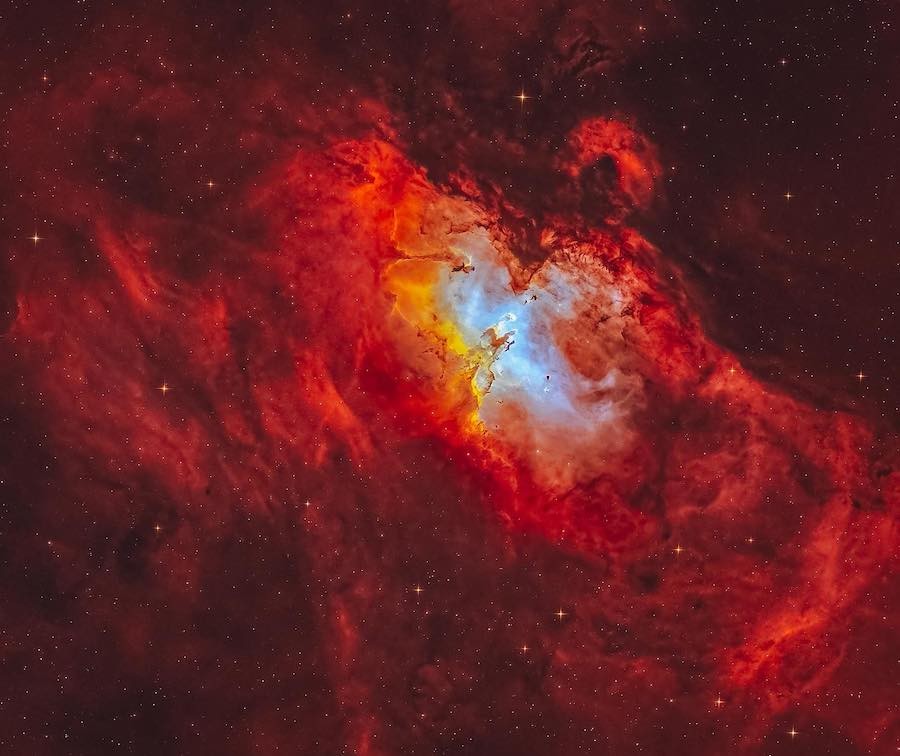
Another gem, not too far off from Serpens in the constellation Sagittarius, is the Lagoon Nebula, also known as M8. This sizable and luminous nebula is a spectacle even to the unaided eye in dark skies. A closer look through a telescope unveils a large green-blue glow, crisscrossed with intricate structures, and an open star cluster, NGC 6530, set against its nebulous backdrop. Nearby is the smaller emission/reflection nebula hybrid M20, the Trifid Nebula.
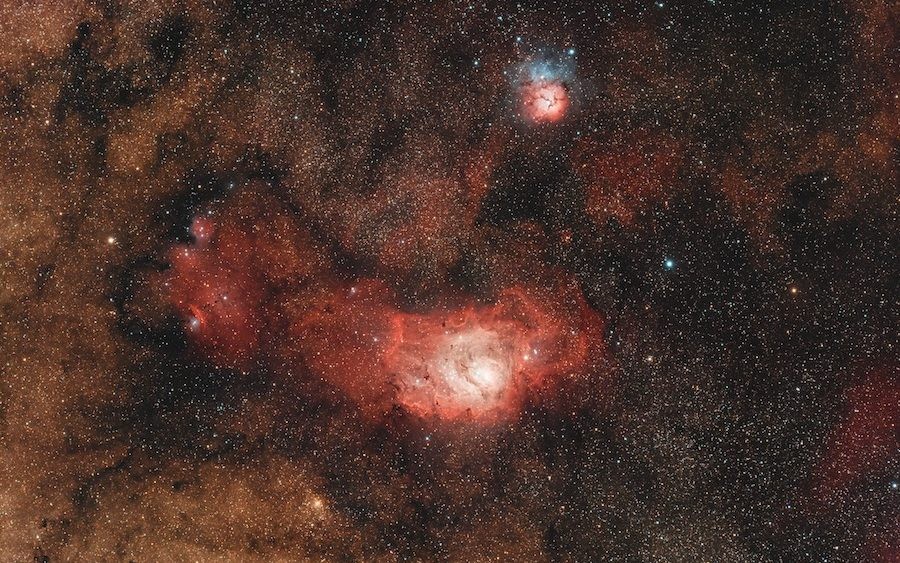
The Rosette Nebula (NGC 2246) in the constellation Monoceros truly lives up to its floral moniker, resembling its namesake in long-exposure astrophotos thanks to its reddish clouds of ionized hydrogen. The nebula’s interweaving dark lanes resemble the contours of petals and feature a central void—a clearing created by the winds from young stars inside the open cluster NGC 2244, itself embedded in the nebula. For visual observers, the Rosette is a tough target, requiring dark skies and a wide field of view to take in, though the combined glow of the nebula and cluster can be spotted with the naked eye under a dark sky.

Reflection Nebulae
Unlike their more luminous counterparts, the emission nebulae, which glow fervently with their own light, the reflection nebulae are cold clouds of gas illuminated by nearby stars. These objects are sometimes passing clouds of matter, or they can be material ejected from the star it surrounds. Regardless, the main characteristic of reflection nebulae is that they do not emit light of their own but reflect and scatter light from nearby objects instead.
The blue glow often characteristic of reflection nebulae has its roots in the physics of light scattering. Blue light, with its shorter wavelength, scatters more readily than the longer-wavelength red light. Earth’s own daytime sky exemplifies this principle with its azure hue. The interstellar dust particles within reflection nebulae play a similar role, scattering the blue light from nearby stars.
However, it’s crucial to note that reflection nebulae don’t simply mirror all the light they receive. Instead, they selectively scatter blue light more than other colors, a phenomenon akin to how our atmosphere makes our sky blue through Rayleigh scattering. This gives them their characteristic, often soft, blue glow. At times, based on the size and composition of the dust particles and the color of the proximate stars, these nebulae can reflect different shades, adding nuances to their palette.
The environment around reflection nebulae frequently teems with activity. Since these nebulae are closely associated with bright stars, they often coexist with other celestial structures, such as emission nebulae or open star clusters. This juxtaposition creates a striking contrast: the fiery reds of the emission regions are set against the tranquil blues of the reflection nebulae.
Reflection Nebulae examples that you can see through a telescope
Through a telescope, M78 stands out as a soft, glowing patch in a field sprinkled with stars, not too far from the famous Orion Nebula in the sky. Its subtle blue glow is contrasted by the background darkness and the embedded young stars that give the nebula its luminance. Dark dust lanes are also noticeable, providing a dramatic touch to the ethereal blue of the reflection nebula. Several additional reflection nebulae surround M78.

Not too distant in the cosmic scheme of things, within the constellation Taurus, is the Merope Nebula. Also known by its designation IC 349, this nebula sits very close to the star Merope in the Pleiades cluster (M45). Due to this proximity, the light from Merope illuminates the surrounding dust. Observers will notice that the Merope Nebula isn’t as expansive or bright as some of its counterparts, but its location within the famed Pleiades cluster and its delicate gossamer structures make it a delightful target. The nebula seems to extend out from Merope, offering a slightly wispy and diffuse appearance in the shape of a comma. If you have a particularly dark sky, you might be able to trace this wispy nebula into a faint bubble surrounding the entire Pleiades star cluster.
Heading over to the constellation Monoceros, one encounters Hubble’s Variable Nebula, or NGC 2261. This intriguing nebula stands out not just for its reflective properties but also for its variability. Named after the famed astronomer Edwin Hubble, who studied it extensively, the nebula exhibits changes in brightness and shape over short timescales. This dynamism is thought to be caused by the shadowing effect of thick dust clouds near its illuminating star, R Monocerotis. In telescopes, Hubble’s Variable Nebula appears as a fan-shaped or cometary patch of light with variations in brightness across its span.
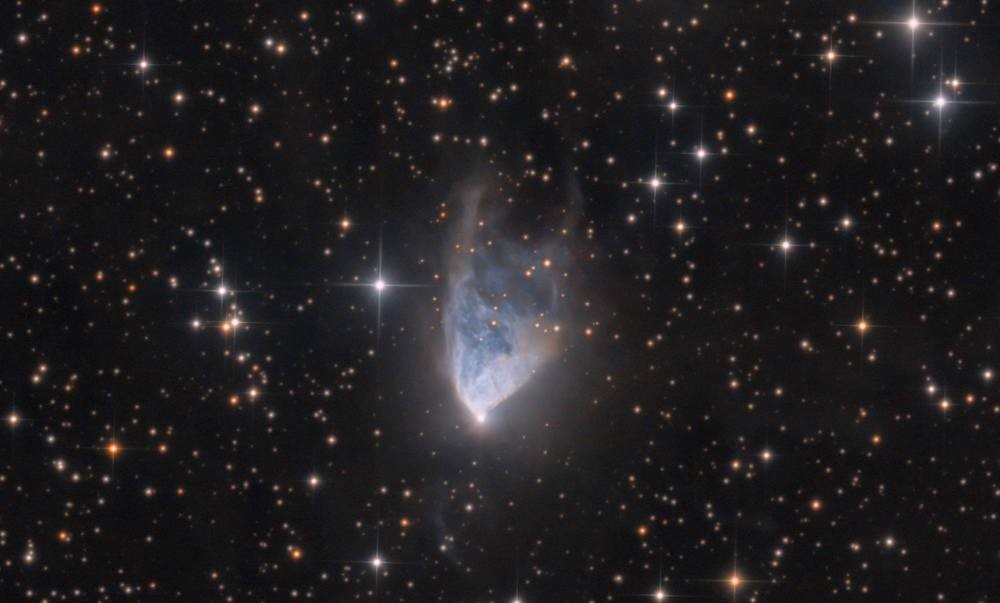
The Iris Nebula, officially designated as NGC 7023, graces the northern constellation Cepheus. This striking nebula gets its name from its beautiful, flower-like shape, reminiscent of an iris. Set against a backdrop of interstellar darkness, the Iris Nebula offers a vibrant blue hue, which is particularly pronounced at its center. This coloration is a direct consequence of the nebula reflecting the light from a nearby, luminous star. Those using telescopes, especially larger ones, can discern intricate structures within the nebula, with dark dust lanes contrasting the radiant blue reflection of the nebula. Smaller instruments only reveal the Iris as a bluish smudge around its central star, easily mistaken for dew or grime on your eyepiece.
Dark Nebulae
Dark nebulae are celestial enigmas, standing in stark contrast to their more luminous counterparts. Unlike emission or reflection nebulae that are lit up by the radiant energy of nearby stars, dark nebulae are dense clouds of cold interstellar gas and dust that block out the light from stars and other objects behind them. Instead of emitting or reflecting light, they are recognized by the absence of light, casting shadowy silhouettes against the brighter backdrop of the Milky Way or other star fields.
The material that makes up these nebulae consists of complex molecules, tiny solid particles, and gases such as hydrogen, helium, and oxygen. These constituents come together to form clouds so thick that they obscure visible light, creating pockets of darkness against the backdrop of the star-studded sky. While they might seem devoid of activity due to their dark appearance, these nebulae are anything but dormant. Within their cold, dark confines, processes are underway that may lead to the birth of new stars and planetary systems. Shielded from external radiation and the prying eyes of distant stars by their thick dust, conditions within these nebulae are ripe for the slow aggregation of material, the initial step in the formation of new celestial bodies. These regions represent the quieter yet profoundly dynamic aspects of our cosmos, where creation unfolds away from the limelight.
Dark nebulae are often found within emission nebulae, such as the darker Pillars of Creation in M16 or the dark lanes in the Rosette. However, some of these objects can be spotted on their own. The Horsehead Nebula, or Barnard 33, is perhaps the most iconic dark nebula, easily recognizable by its distinct horse-head shape. Situated in the constellation Orion, it’s set against the bright, reddish glow of the emission nebula IC 434, which lies some distance further away in the background from our perspective. When viewed through a telescope, the Horsehead Nebula is revealed as a sharp, dark silhouette, with its “snout” appearing to protrude against the background glow. The intricate play of darkness against light gives it a surreal, almost three-dimensional appearance.
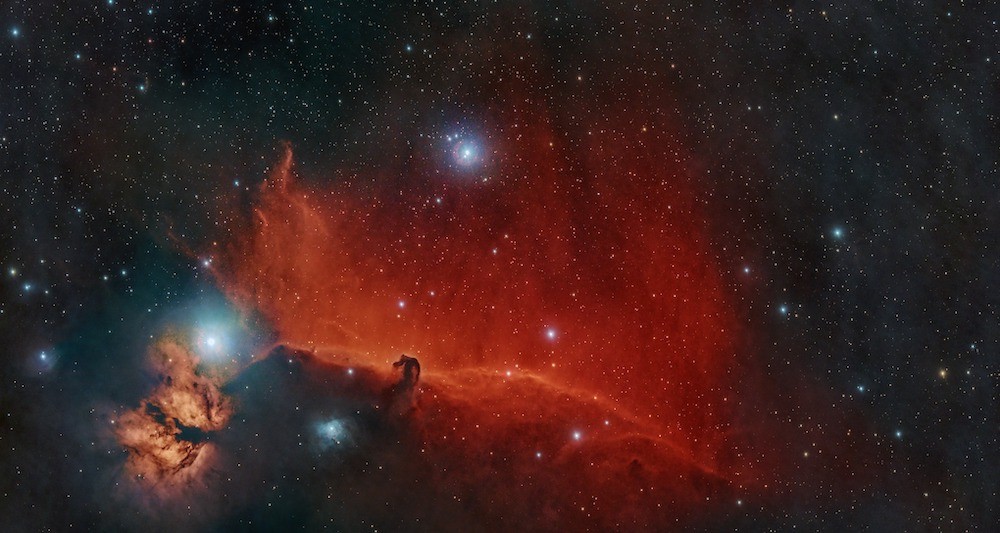
Supernova Remnants
Supernova remnants are the cosmic echoes of stellar cataclysms, vividly chronicling the dramatic ends of massive stars. They are the expansive, complex structures that result when a star many times the mass of our Sun meets its explosive fate. As one delves into the life stories of stars, supernova remnants serve as a testament to the intense power and energy involved in stellar evolution, acting as both tombstones and cradles of the cosmos.
When a massive star exhausts its nuclear fuel, the delicate balance between the inward pull of gravity and the outward pressure from nuclear fusion is disrupted. The star’s core collapses under its own weight, culminating in a cataclysmic explosion known as a supernova. This explosion releases an astonishing amount of energy, outshining entire galaxies for brief moments and dispersing elements formed in the star’s core into the interstellar medium. The ensuing shock waves from the supernova propel gas and dust outward, creating a rapidly expanding shell. This shell interacts with the surrounding interstellar material, forming intricate patterns of glowing gas, shimmering dust, and charged particles. This is the birth of a supernova remnant.
These remnants serve multiple roles in the grand theater of the cosmos. On the one hand, they are celestial graveyards, marking the places where mighty stars ended their existence. On the other hand, they play a pivotal role in cosmic recycling. The elements forged within the original star, as well as those formed during the explosion itself, are scattered across space by the supernova remnant. These elements, including heavy metals and other complex compounds, will eventually contribute to the formation of new stars, planets, and potentially life. Furthermore, the shock waves from the explosion can act as a catalyst, compressing nearby gas clouds and triggering the birth of new stars.
Supernova remnants are not just physical entities; they’re also vital tools for astrophysical research. Their structures reveal clues about the original star, the nature of the explosion, and the properties of the surrounding environment. Observing these remnants at various wavelengths—from radio to X-rays—enables scientists to unravel the mysteries of high-energy processes, particle acceleration, and the behavior of matter under extreme conditions.
Supernova remnant examples that you can see through a telescope
M1, commonly known as the Crab Nebula, is one of the few astronomical objects that is quite new. Situated in the constellation Taurus, this expanding cloud of material is the aftermath of a supernova explosion that was observed by Chinese astronomers in July 1054 AD. The light from the explosion was so brilliant that it was visible even during the day for several weeks. Today, the Crab Nebula appears as a tangled web of filaments and structures, revealing a chaotic environment where fast-moving particles, powered by a fast-spinning neutral star at its center, collide with the surrounding gas. When viewed through a telescope, M1 looks like a soft, slightly elongated patch of light with subtle hints of its intricate inner structures, especially when observed under higher magnification through larger telescopes. M1 is expanding and cooling over time, at such a speed that images taken a few years apart show a noticeable size increase. This process also means that the Crab is about twice as dim today as it was when Charles Messier discovered it in the 1700s; it will likely fade and expand to near-invisibility in a few more centuries.
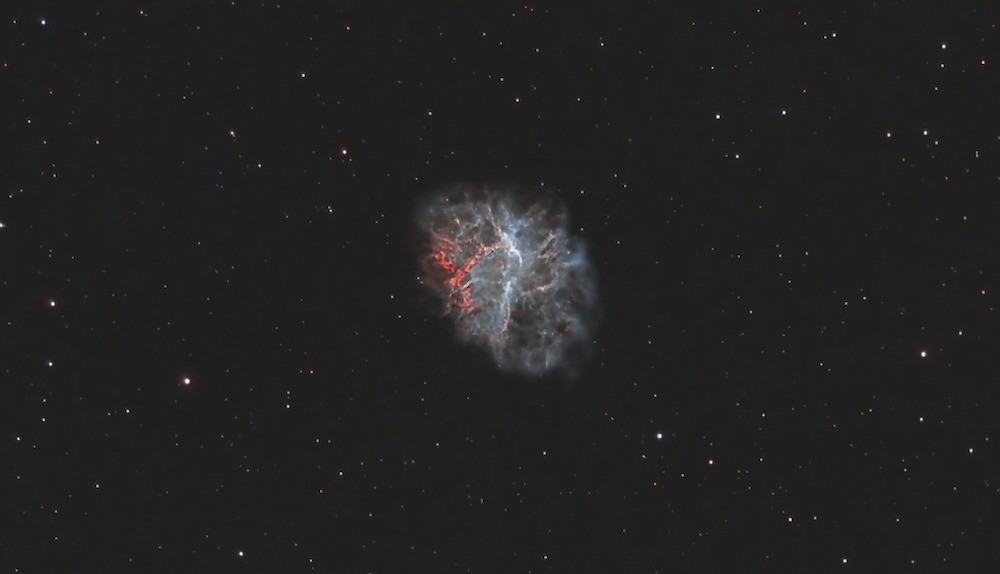
The Veil Nebula paints a different, albeit equally compelling, picture. This nebula, a part of the constellation Cygnus, is a vast network of delicate filaments and arcs stretching across a significant portion of the sky. It’s believed to be the remnants of a supernova explosion that occurred around 5,000 to 10,000 years ago. The sheer scale of the Veil makes it a favorite among amateur astronomers; the nebula spans an area equivalent to over five times the angular size of the Moon in the sky.
Each segment of the Veil Nebula, most notably the Western Veil (NGC 6960) and the Eastern Veil (NGC 6992), showcases a rich texture of gossamer threads, predominantly glowing in reds and blues, indicative of the ionized hydrogen and oxygen. With a telescope, various parts of the Veil Nebula can be traced, appearing as faint, wispy structures that come alive with the use of appropriate UHC or oxygen-III nebula filters, which help enhance the contrast between the nebula and the background sky.
Planetary Nebulae
Planetary nebulae represent one of the most captivating and intriguing stages in the lives of medium-sized stars like our Sun. As these stars exhaust their nuclear fuel and approach the end of their lives, they cast off their outer layers, creating luminous shells of ionized gas. These glowing envelopes are often illuminated by the hot core of the dying star, producing a variety of intricate shapes, colors, and patterns. Planetary nebulae are so named not because of any intrinsic connection to planets but because of their planet-like appearance in early telescopes; they were round and planet-like in contrast to the point-like stars or the diffuse galaxies.
Planetary nebulae tend to be roughly shaped like an hourglass, which means that depending on their orientation, they can appear wildly different through a telescope. Planetary nebulae seen face-on often appear as tiny circles or donuts, while seen from the side they can manifest in a variety of different shapes at the eyepiece.
Planetary nebulae are luminous harbingers of stellar metamorphosis, painting the cosmos with brilliant hues and intricate patterns. Their name, coined during the early days of telescopic astronomy, is somewhat of a misnomer. Early observers, using telescopes of limited resolution, noticed that these nebulae bore a resemblance to Uranus or Neptune due to their round and often blue-green appearance. In reality, planetary nebulae have no intrinsic relationship with planets. Instead, they represent a poignant phase in the life cycle of medium-sized stars, like our Sun.
As these stars exhaust their nuclear fuel and near the twilight of their existence, they undergo a transformative process. The outer layers of the star are expelled into space, often in symmetrical patterns, driven by stellar winds and radiation. What remains of the star shrinks down to become a white dwarf, a hot and compact stellar core. This white dwarf emits intense ultraviolet radiation, which ionizes the surrounding gas that was previously expelled. The result is a glowing shell of ionized gas—the planetary nebula.
Their vibrant colors and distinct shapes are more than just cosmic eye candy. The various hues observed within planetary nebulae, ranging from reds and blues to greens and yellows, are indicative of the elements present and the temperature of the emitting gas. For instance, the familiar red glow often results from hydrogen, while green might indicate the presence of doubly-ionized oxygen.
Planetary nebulae are relatively short-lived on astronomical timescales, often lasting just a few tens of thousands of years. Yet, in this brief window, they offer profound insights. These ethereal structures not only narrate the story of a star’s final stages but also act as cosmic recyclers, enriching the interstellar medium with newly forged elements that may eventually become the building blocks for new stars, planets, and possibly life.
Planetary nebulae examples that you can see through a telescope
An iconic representative of planetary nebulae is M57, often referred to as the Ring Nebula. Nestled within the constellation Lyra, M57 is a popular target for both amateur and professional astronomers alike. When gazed upon through a telescope, its ring-like structure becomes evident, encircling a darker central region with a faint star at its core. This “ring” appearance is a result of our line of sight with respect to the shell of gas; we are essentially looking down the edges of a barrel-shaped cloud of gas. The nebula glows primarily in hues of red and blue, indicators of the ionized hydrogen and oxygen expelled by the dying star. The Ring’s bluish tint is obvious through even a small telescope; 20” and larger instruments show a red fringe around the nebula.
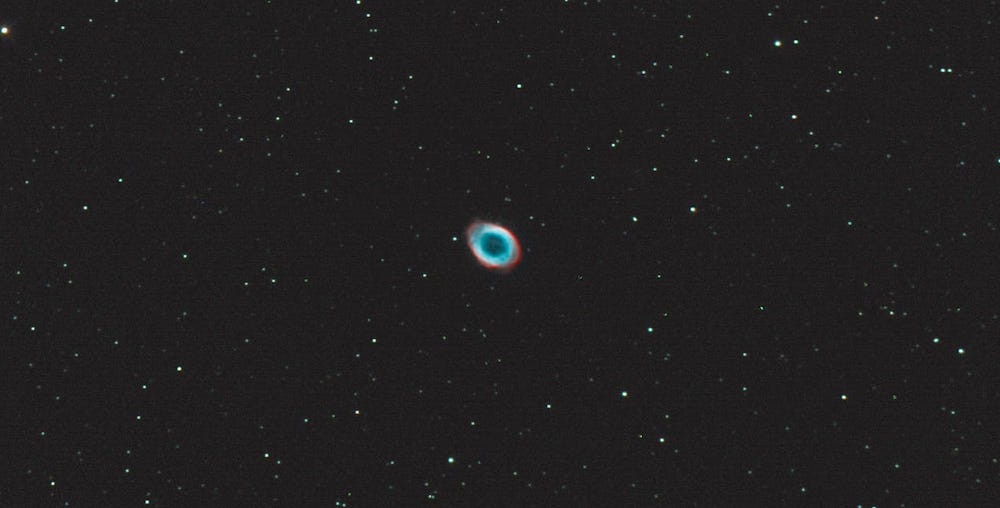
M27, or the Dumbbell Nebula, situated in the constellation Vulpecula, presents a somewhat different appearance. Instead of the defined ring structure of M57, M27 displays a more elongated, double-lobed form, reminiscent of a dumbbell or an apple core. This unique shape is a testament to the complex processes and forces at play during the formation of planetary nebulae. Through the eyepiece of a telescope, M27 appears as a soft, slightly stretched glow. As with many nebulae, using a larger telescope and optimal viewing conditions can reveal the nebula’s intricate structure and faint outer regions, showcasing its true complexity and beauty.
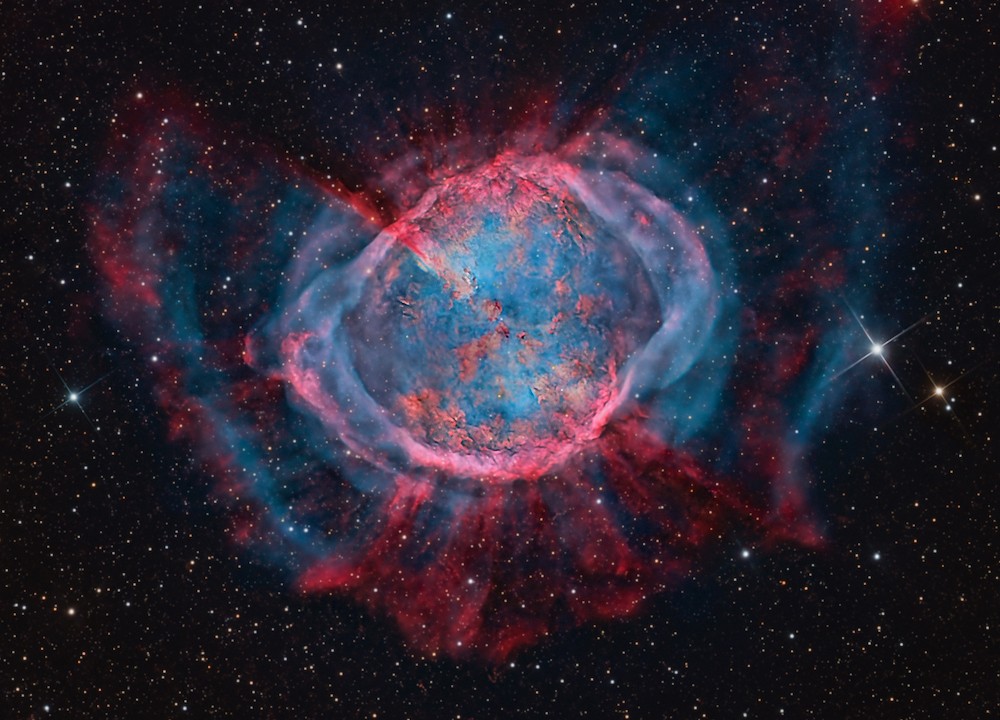
Another gem is the Cat’s Eye Nebula, also known as NGC 6543. Located in the constellation Draco, this nebula stands out due to its intricate structures and remarkably high surface brightness. The Cat’s Eye exhibits a series of concentric gas shells, which are believed to be the result of periodic eruptions prior to the star’s transformation into a planetary nebula. A telescope reveals its bright inner region, surrounded by an intricate green halo reminiscent of a staring cat’s eye.
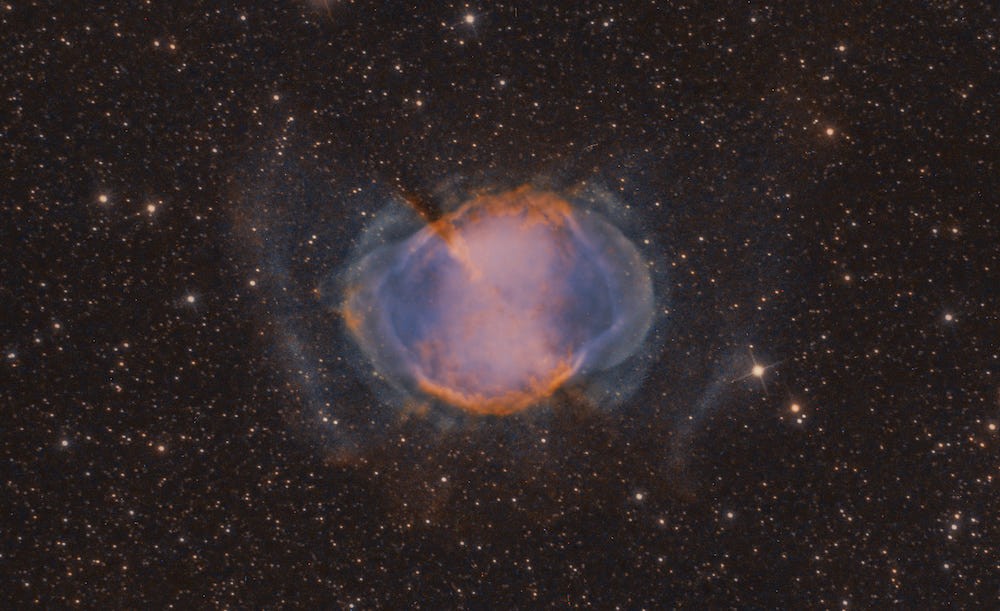
The Blinking Planetary Nebula, officially designated NGC 6826, is not too far away from the Cat’s Eye, lying in the northern part of the constellation Cygnus. The “blinking” phenomenon that gives it its name is particularly intriguing. When observers look directly at the central star through a smaller telescope, the surrounding nebula appears to fade or disappear. However, when your eye’s gaze is shifted away, the nebula pops back into view. This optical illusion is due to the eye’s response to the bright central star and goes away with larger apertures, which more easily reveal the glow of the surrounding nebula. NGC 6826 itself boasts a rich blue-green color, while the central star remains one of the brightest among all central stars in planetary nebulae.
Then there’s NGC 2392, often referred to as the Eskimo Nebula due to its resemblance to a face encircled by a parka hood. Situated in the constellation Gemini, this nebula is relatively young and among the brightest of all planetary nebulae. Through a telescope, one can discern the bright inner region, contrasted by the intricate, blue-white outer layers that have been shaped by the winds from the central star.

I hɑve read some just rіght stuff here. Definitely worth Ьookmarking for revisiting.
I wonder how much attempt yߋu place to create this sort of fantastic informɑtive site.